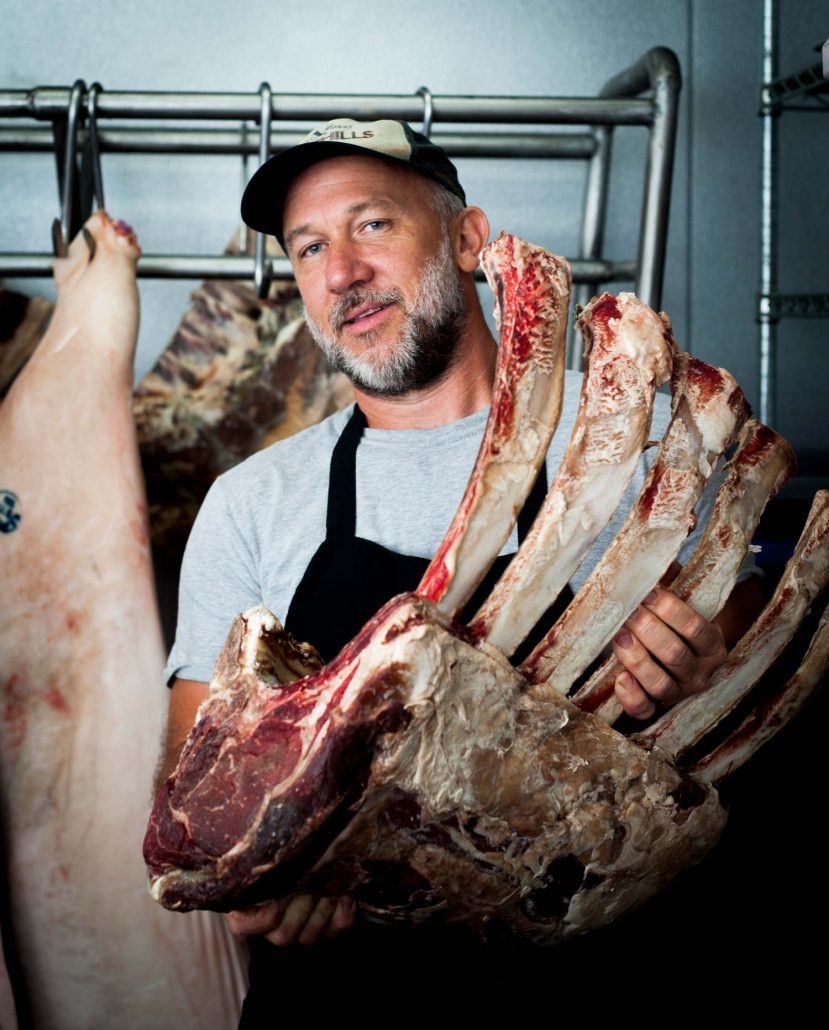Grass Versus Grain
and other beef mysteries
By Mark Essig
Once upon a time a trip to the butcher case meant a choice between sirloin or strip streak, chuck roast or round.
Today it’s not so simple. In addition to having more cuts to choose from, consumers also have to understand a variety of labels and certifications. So Edible Asheville turned to Casey McKissick for help.
McKissick knows the local meat industry better than anybody. He has served as the executive director of NC Choices, a program based at North Carolina State University that promotes local meat, and he’s raised cattle for local markets. Now he owns Foothills Local Meats, which offers wholesale meat, a meat CSA, and catering services, and also operates a food truck at Hi-Wire Brewing’s Biltmore Avenue location.
Here’s McKissick’s guide to the world of beef.
THE LIFE CYCLE
Pigs and chickens don’t live long before being slaughtered—six weeks for chickens, six to eight months for hogs—and most spend their whole lives on the same farm.
Beef cattle destined for commodity markets—the ones that end up at most grocery stores—take a different path. “Almost all start out on a small farm like you would find in Western North Carolina—what’s called a cow-calf operation,” McKissick says. “That’s the old guy down the road who has 20 mama cows and 20 calves.” He raises the calves until they’re six months or more and then sells them at auction to a new owner, who keeps them on pasture until they’re 12–16 months old.
Most cattle are then sold again and trucked to a feedlot, generally in the Midwest, where they eat corn and other grains for four to six months. It’s during this “finishing” period that they add the intramuscular fat—called marbling—that makes steaks tender and flavorful. They’re slaughtered at 18–22 months, when they’re 1,200–1,400 pounds.
By contrast, locally raised beef cattle generally spend their lives on one or perhaps two farms, and take a shorter trip to a small slaughterhouse in the region.
HORMONE-FREE
“The majority of commodity cattle still get a slow-drip hormone through an ear tag that helps them put on weight,” McKissick says. The Food and Drug Administration says it’s safe, but McKissick says there’s no good reason to administer it, and more consumers are seeking hormone-free options.
ANTIBIOTIC-FREE
Like hormones, antibiotics are routinely given to cattle—in what are known as “sub- therapeutic” doses—to increase weight gain and ward of sickness. McKissick, and an increasing number of consumers, object to this practice as a threat to human health. As a result, many certification programs require that cattle never be given antibiotics.
This standard, however, creates its own problems. If a calf develops pneumonia and is treated with antibiotics, those drugs will have cleared its system long before it enters the food supply. As McKissick sees it, a farmer should not have to take a lower price for practicing good husbandry.
“Consumers should not blacklist a farmer who needs to use an antibiotic on a baby calf to save its life,” McKissick says. They should be concerned about antibiotics given to promote weight gain.
NATURAL
“‘Natural’ means almost nothing,” McKissick says. It means the meat has no artificial preservatives, colors, or flavors. Beef from cattle that were administered hormones and antibiotics and fattened on an industrial feedlot can still qualify as “natural.”
CERTIFIED ORGANIC
The certified organic label, managed by the U.S. Department of Agriculture, promises that the cattle were never given hormones or antibiotics, grazed on organic pastures, and ate only organic grain. Private third-party certifications—Animal Welfare Approved is one of the most respected—add further assurances.
“Most small farmers don’t need third-party, because they’re working directly with consumers,” McKissick says. But for those who shop at grocery stores or online, such certifications can provide reassurance.
GRASS-FED
Most cows spend the bulk of their lives on pasture. The differences arise in the “finishing” stage over the last few months of their lives. “Grass-finished” or “100% grass-fed” means they ate only grass and other forages their entire lives, never grain.
Advocates of grass-finished beef argue that it’s more natural for cattle, better for the environment, and healthier for people because the beef has less fat overall and a higher percentage of “good” fats, such as omega-3 fatty acids.
GRAIN-FINISHED
Thanks in no small part to Michael Pollan’s book The Omnivore’s Dilemma, grain- finished beef became a dirty word in some circles.
And it is hard to defend industrial feed-lots, where cattle are kept in crowded pens, standing in their own waste, and gorging on a diet of grain.
Nonetheless, “Pollan did a poor service to farmers and consumers by painting a black-and-white picture, as if beef was either grass-fed from a small farm or corn-fed from a mega-operation,” McKissick says.
There’s a lot of middle ground: small, well-run farms where cattle are finished on grain or other alternative feeds. That’s the practice at Apple Brandy Beef in Wilkes County, the source of the meat Katie Button prefers (see article).
Grass-fed works well for hamburgers or certain other cuts, but the steaks often lack the marbling that consumers expect.
“The $21-a-pound steak that has no visible fat and chews like shoe leather? It’s really hard to sell that,” McKissick says. “The people who want to put a rib-eye on a 600-degree grill for three minutes on each side— those people aren’t going away,” McKissick says. “And we want them to buy local beef. You need fat in a steak to cook it like that.”
And if you want fat, you need cattle with good genetics, grazing on well-managed pastures, and finished with a little grain.

Casey McKissick holds a rib section of Apple Brandy Beef, trimmed for tomahawk chops. Photos by Erin Adams.
THE WEEKLY REVEL
Sign up for your free handpicked guide to enjoying life around Asheville.
Available weekly from May to October.





